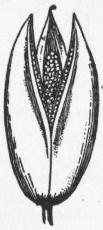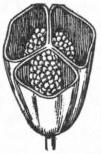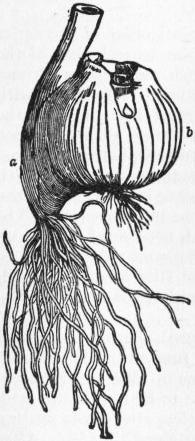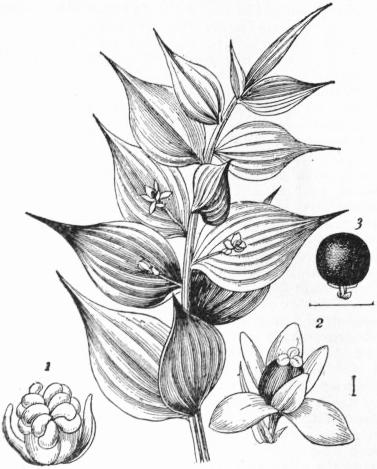Liliaceae
 From Britannica 11th Edition (1911)
From Britannica 11th Edition (1911) Liliaceae, in botany, a natural order of Monocotyledons belonging to the series Liliiflorae, and generally regarded as representing the typical order of Monocotyledons. The plants are generally perennial herbs growing from a bulb or rhizome, sometimes shrubby as in butcher’s broom (Ruscus) or tree-like as in species of Dracaena, Yucca or Aloe. The flowers are with few exceptions hermaphrodite, and regular with parts in threes (fig. 5), the perianth which is generally petaloid occupying the two outer whorls, followed by two whorls of stamens, with a superior ovary of three carpels in the centre of the flower; the ovary is generally three-chambered and contains an indefinite number of anatropous ovules on axile placentas (see fig. 2). The fruit is a capsule splitting along the septa (septicidal) (fig. 1), or between them (loculicidal), or a berry (fig. 6, 3); the seeds contain a small embryo in a copious fleshy or cartilaginous endosperm. Liliaceae is one of the larger orders of flowering plants containing about 2500 species in 200 genera; it is of world-wide distribution. The plants show great diversity in vegetative structure, which together with the character and mode of dehiscence of the fruit afford a basis for the subdivision of the order into tribes, eleven of which are recognized. The following are the most important tribes.
 |
 |
| Fig. 1.—Fruit or Capsule of Meadow Saffron (Colchicum autumnale) dehiscing along the septa. | Fig. 2.—Same cut across showing the three chambers with the seeds attached along the middle line—axile placentation. |
 |
 |
| Fig. 3.—Corm of Meadow Saffron (Colchicum autumnale). a, Old corm shrivelling; b, young corm produced laterally from the old one. | Fig. 4.—Corm of Colchicum autumnale in autumn when the plant is in flower. |
k, Present corm. h, h, Brown scales covering it. w, Its roots. st, Its withered flowering stem. k′, Younger corm produced from k. wh, Roots from k′, which grows at expense of k. s, s′, s″, Sheathing leaves. l′, l″, Foliage leaves. b, b′, Flowers. k″, Young corm produced from k′, in autumn, which in succeeding autumn will produce flowers. |
Melanthoideae.—The plants have a rhizome or corm, and the fruit is a capsule. It contains 36 genera, many of which are north temperate and three are represented in Britain, viz. Tofieldia, an arctic and alpine genus of small herbs with a slender scape springing from a tuft of narrow ensiform leaves and bearing a raceme of small green flowers; Narthecium (bog-asphodel), herbs with a habit similar to Tofieldia, but with larger golden-yellow flowers; and Colchicum, a genus with about 30 species including the meadow saffron or autumn crocus (C. autumnale). Colchicum illustrates the corm-development which is rare in Liliaceae though common in the allied order Iridaceae; a corm is formed by swelling at the base of the axis (figs. 3, 4) and persists after the flowers and leaves, bearing next season’s plant as a lateral shoot in the axil of a scale-leaf at its base. Gloriosa, well known in cultivation, climbs by means of its tendril-like leaf-tips; it has handsome flowers with decurved orange-red or yellow petals; it is a native of tropical Asia and Africa. Veratrum is an alpine genus of the north temperate zone.
Asphodeloideae.—The plants generally have a rhizome bearing radical leaves, as in asphodel, rarely a stem with a tuft of leaves as in Aloe, very rarely a tuber (Eriospermum) or bulb (Bowiea). The flowers are borne in a terminal raceme, the anthers open introrsely and the fruit is a capsule, very rarely, as in Dianella, a berry. It contains 64 genera. Asphodelus (asphodel) is a Mediterranean genus; Simethis, a slender herb with grassy radical leaves, is a native of west and southern Europe extending into south Ireland. Anthericum and Chlorophytum, herbs with radical often grass-like leaves and scapes bearing a more or less branched inflorescence of small generally white flowers, are widely spread in the tropics. Other genera are Funkia, native of China and Japan, cultivated in the open air in Britain; Hemerocallis, a small genus of central Europe and temperate Asia—H. flava is known in gardens as the day lily; Phormium, a New Zealand genus to which belongs New Zealand flax, P. tenax, a useful fibre-plant; Kniphofia, South and East Africa, several species of which are cultivated; and Aloe. A small group of Australian genera closely approach the order Juncaceae in having small crowded flowers with a scarious or membranous perianth; they include Xanthorrhoea (grass-tree or black-boy) and Kingia, arborescent plants with an erect woody stem crowned with a tuft of long stiff narrow leaves, from the centre of which rises a tall dense flower-spike or a number of stalked flower-heads; this group has been included in Juncaceae, from which it is doubtfully distinguished only by the absence of the long twisted stigmas which characterize the true rushes.
Allioideae.—The plants grow from a bulb or short rhizome; the inflorescence is an apparent umbel formed of several shortened monochasial cymes and subtended by a pair of large bracts. It contains 22 genera, the largest of which Allium has about 250 species—7 are British; Agapanthus or African lily is a well-known garden plant; in Gagea, a genus of small bulbous herbs found in most parts of Europe, the inflorescence is reduced to a few flowers or a single flower; G. lutea is a local and rare British plant.
Lilioideae.—Bulbous plants with a terminal racemose inflorescence; the anthers open introrsely and the capsule is loculicidal. It contains 28 genera, several being represented in Britain. The typical genus Lilium and Fritillaria are widely distributed in the temperate regions of the northern hemisphere; F. meleagris, snake’s head, is found in moist meadows in some of the southern and central English counties; Tulipa contains more than 50 species in Europe and temperate Asia, and is specially abundant in the dry districts of central Asia; Lloydia, a small slender alpine plant, widely distributed in the northern hemisphere, occurs on Snowdon in Wales; Scilla (squill) is a large genus, chiefly in Europe and Asia—S. nutans is the bluebell or wild hyacinth; Ornithogalum (Europe, Africa and west Asia) is closely allied to Scilla—O. umbellatum, star of Bethlehem, is naturalized in Britain; Hyacinthus and Muscari are chiefly Mediterranean; M. racemosum, grape hyacinth, occurs in sandy pastures in the eastern counties of England. To this group belong a number of tropical and especially South African genera such as Albuca, Urginea, Drimia, Lachenalia and others.
Dracaenoideae.—The plants generally have an erect stem with a crown of leaves which are often leathery; the anthers open introrsely and the fruit is a berry or capsule. It contains 9 genera, several of which, such as Yucca (fig. 5), Dracaena and Cordyline include arborescent species in which the stem increases in thickness continually by a centrifugal formation of new tissue; an extreme case is afforded by Dracaena Draco, the dragon-tree of Teneriffe. Yucca and several allied genera are natives of the dry country of the southern and western United States and of Central America. Dracaena and the allied genus Cordyline occur in the warmer regions of the Old World. There is a close relation between the pollination of many yuccas and the life of a moth (Pronuba yuccasella); the flowers are open and scented at night when the female moth becomes active, first collecting a load of pollen and then depositing her eggs, generally in a different flower from that which has supplied the pollen. The eggs are deposited in the ovary-wall, usually just below an ovule; after each deposition the moth runs to the top of the pistil and thrusts some pollen into the opening of the stigma. Development of larva and seed go on together, a few of the seeds serving as food for the insect, which when mature eats through the pericarp and drops to the ground, remaining dormant in its cocoon until the next season of flowering when it emerges as a moth.
 |
| Fig. 5.—Yucca gloriosa. Plant much reduced. 1, Floral diagram. 2, Flower. |
 |
| Fig. 6.—Twig of Butcher’s Broom, Ruscus aculeatus, slightly enlarged. 1, Male flower, 2, female flower, both enlarged; 3, berry, slightly reduced. |
 |
| From Strasburger’s Lehrbuch der Botanik, by permission of Gustav Fischer. |
| Fig. 7.—Rhizome of Polygonatum multiflorum. |
a, Bud of next year’s aerial shoot. b, Scar of this year’s, and c, d, e, scars of three preceding years’ aerial shoots. w, Roots. |
Asparagoideae.—Plants growing from a rhizome; fruit a berry. Asparagus contains about 100 species in the dryer warmer parts of the Old World; it has a short creeping rhizome, from which springs a slender, herbaceous or woody, often very much branched, erect or climbing stem, the ultimate branches of which are flattened or needle-like leaf-like structures (cladodes), the true leaves being reduced to scales or, in the climbers, forming short, hard more or less recurved spines. Ruscus aculeatus (fig. 6) is butcher’s broom, an evergreen shrub with flattened leaf-like cladodes, native in the southerly portion of England and Wales; the small flowers are unisexual and borne on the face of the cladode; the male contains three stamens, the filaments of which are united to form a short stout column on which are seated the diverging cells of the anthers; in the female the ovary is enveloped by a fleshy staminal tube on which are borne three barren anthers. Polygonatum and Maianthemum are allied genera with a herbaceous leafy stem and, in the former axillary flowers, in the latter flowers in a terminal raceme; both occur rarely in woods in Britain; P. multiflorum is the well-known Solomon’s seal of gardens (fig. 7), so called from the seal-like scars on the rhizome of stems of previous seasons, the hanging flowers of which contain no honey, but are visited by bees for the pollen. Convallaria is lily of the valley; Aspidistra, native of the Himalayas, China and Japan, is a well-known pot plant; its flowers depart from the normal arrangement of the order in having the parts in fours (tetramerous). Paris, including the British Herb Paris (P. quadrifolia), has solitary tetra- to poly-merous flowers terminating the short annual shoot which bears a whorl of four or more leaves below the flower; in this and in some species of the nearly allied genus Trillium (chiefly temperate North America) the flowers have a fetid smell, which together with the dark purple of the ovary and stigmas and frequently also of the stamens and petals, attracts carrion-loving flies, which alight on the stigma and then climb the anthers and become dusted with pollen; the pollen is then carried to the stigmas of another flower.
Luzuriagoideae are shrubs or undershrubs with erect or climbing branches and fruit a berry. Lapageria, a native of Chile, is a favourite greenhouse climber with fine bell-shaped flowers.
Smilacoideae are climbing shrubs with broad net-veined leaves and small dioecious flowers in umbels springing from the leaf-axils; the fruit is a berry. They climb by means of tendrils, which are stipular structures arising from the leaf-sheath. Smilax is a characteristic tropical genus containing about 200 species; the dried roots of some species are the drug sarsaparilla.
The two tribes Ophiopogonoideae and Aletroideae are often included in a distinct order, Haemodoraceae. The plants have a short rhizome and narrow or lanceolate basal leaves; and they are characterized by the ovary being often half-inferior. They contain a few genera chiefly old world tropical and subtropical. The leaves of species of Sansevieria yield a valuable fibre.
Liliaceae may be regarded as the typical order of the series Liliiflorae. It resembles Juncaceae in the general plan of the flower, which, however, has become much more elaborate and varied in the form and colour of its perianth in association with transmission of pollen by insect agency; a link between the two orders is found in the group of Australian genera referred to above under Asphodeloideae. The tribe Ophiopogonoideae, with its tendency to an inferior ovary, suggests an affinity with the Amaryllidaceae which resemble Liliaceae in habit and in the horizontal plan of the flower, but have an inferior ovary. The tribe Smilacoideae, shrubby climbers with net-veined leaves and small unisexual flowers, bears much the same relationship to the order as a whole as does the order Dioscoreaceae, which have a similar habit, but flowers with an inferior ovary, to the Amaryllidaceae.
↧ Download as ZWI file | Last modified: 11/17/2022 15:24:21 | 42 views
☰ Source: https://oldpedia.org/article/britannica11/Liliaceae | License: Public domain in the USA. Project Gutenberg License
 ZWI signed:
ZWI signed: KSF
KSF